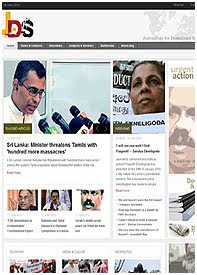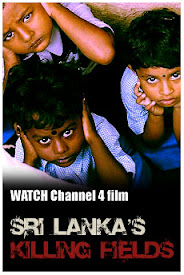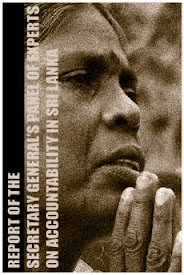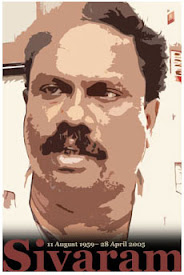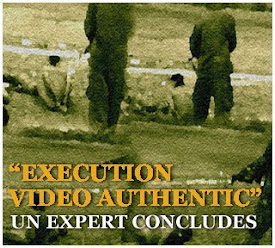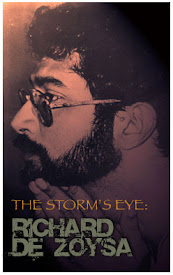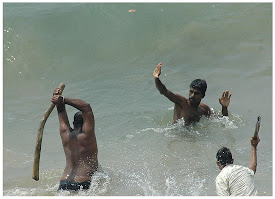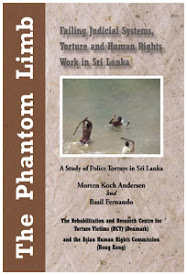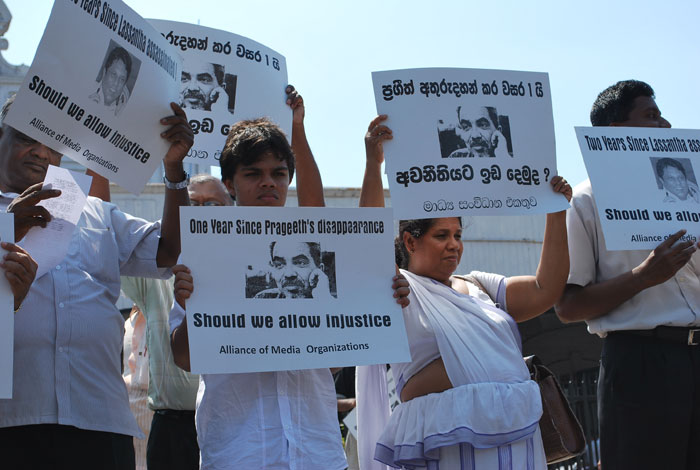
Photo courtesy: Vikalpa.org
By Bharatha Mallawarachi | The Canadian Press
.............................................................................................................................................................................................
About 100 demonstrators gathered Tuesday in front of the main railway station in the Sri Lankan capital to complain that no one has been arrested in connection with the killing of a prominent journalist two years ago, the disappearance of another last year and an attack on a television station.
Lasantha Wickrematunge, editor of The Sunday Leader newspaper, was shot dead in his car by assailants on Jan. 8, 2009. The paper had been critical of the government's conduct in the war against the now-defeated Tamil Tiger rebels and reported on alleged human rights violations and government corruption.
Two days before his killing, armed men attacked privately owned Sirasa television station, with hand grenades and gunfire that started a fire causing heavy damage to its studios.
"Two years have passed since the killing of Lasantha and attack on Sirasa, but the government has failed to bring any culprit before the law and punish them" said Gnanasiri Kottigoda, president of the Sri Lanka Working Journalists' Association.
Paris-based Reporters Without Borders has accused the government of hindering an investigation into Wickrematunge's killing.
Prageeth Ekneligoda, a political columnist and cartoonist with Lankaenews.com, was reported missing and is believed to have been abducted while on his way home from work a year ago.
Ekneligoda supported the opposition candidate in last year's presidential election and disappeared two days before the poll.
The government has repeatedly denied any coverups and said that it continues to investigate the crimes.
Media rights groups say Sri Lanka is among the most dangerous places in the world for journalists. Amnesty International says at least 14 Sri Lankan media workers have been killed since the beginning of 2006. They blame the government for failing to properly investigate several other attacks on media and arrest the culprits.
© The Canadian Press
Wednesday, January 19, 2011
Sri Lankan journalists demands justice for killed, disappeared journalists
Wednesday, January 19, 2011
Pakistan Army Chief to visit Sri Lanka today

By Santhush Fernando | Asian Tribune
.............................................................................................................................................................................................
His visit comes in the wake of Commander of Indian Air Force Air Chief Marshal Pradeep Vasant Naik’s four day official visit to Colombo.
Gen. Kayani is scheduled call on President Mahinda Rajapaksa, Defence Secretary Gotabaya Rajapaksa and commanders of Sri Lanka’s tri-forces.
His visit was preceded by visits by Pakistani President Asif Ali Zardari in last November and by Pakistani Air Force Commander Air Chief Marshal Rao Qamar Suleman three-day official visit last year.
A distinguished alumni of Jhelum Military College and Pakistan Military Academy in Kakul, Gen. Kayani is regarded by many as a true leader having a futuristic vision for the country’s military. He is also a graduate of United States Army Infantry School, Fort Benning, Georgia; Command and Staff College, Fort Levinworth, Kansas; Asia Pacific Center for Security Studies, Honolulu, Hawai; and National Defence College, Islamabad.
General Ashfaq Parvez Kayani, born in 1952, is a four star general in the Pakistan Army, who replaced General Pervez Musharraf as the Chief of Army Staff (CoAS) and the commandant of the army on November 29, 2007.
Gen. Kayani was hailed for his leadership portrayed during his stints in the past as the former Director General of Pakistan's Inter-Services Intelligence (ISI), and Director General of Military Operations (MO). Last July, Prime Minister Yousaf Raza Gillani extended Gen. Kayani’s term as CoAS by three years, making him the first Pakistani army chief to receive a term extension from any democratically-elected government.
Gen. Kayani was hailed by many, after he ordered military officers not to have links with politicians in January 2008 leading to the de-militarisation of Pakistan’s public administration. Later on he ordered the withdrawal of military officers from non-military public service reversing the policies of his predecessor, President Musharraf.
His gallantry shown during Indo-Pakistani War of 1971, India–Pakistan standoff War in 2001 and the war in North-West Pakistan were highly commended.
In 2008 August following a request from Gen. Kayani, Sri Lanka Army Commander Lt Gen Jagath Jayasuriya said that Sri Lanka had happily agreed to give training to members of the Pakistani military.
Although India backed out from supplying military equipment to Sri Lanka during the final lap of the war, Pakistan had been a constant friend of Sri Lanka by continuing its supplies which was cited by many as being vital during that crucial stage.
© Asian Tribune
Wednesday, January 19, 2011
Indian Air Chief in Lanka to deepen military ties

Press Trust of India | One India News
.............................................................................................................................................................................................
Air Chief Marshal Naik paid floral tributes at a landmark monument built near Sri Lanka''s parliamentary complex to honour 1,200 IPKF soldiers who died during the fighting with LTTE as part of the 1987 Indo-Lanka Peace Accord aimed at resolving the ethnic crisis in the country.
The Indian air chief received a red carpet welcome and a guard of honour at the air force headquarters, where he met his counterpart Air Chief Marshal Roshan Goonatilake on Monday (17).
Later he was briefed on the role and task of the Sri Lanka air force, officials said.
During his stay, the Air Force Chief will had several meetings with top officials of the government and the defence establishment, including the powerful Defence Secretary Gotabhaya Rajapksha and service chiefs in a bid to deepen military ties between the two neighbors.
Indian Air Chief was scheduled to call on president Mahinda Rajapksha and External Affairs Minister Prof.G.L.Pieris on Tuesday (18).
He will also visit Sri Lanka Air Force base at Katunayake, the home of Sri Lanka''s fighter jet squadron.
© One India News
Wednesday, January 19, 2011
Disease, hunger and mines threaten flood-hit Sri Lankans - UN

Alter Net
.............................................................................................................................................................................................
Aid workers fear there could be outbreaks of dengue fever and cholera and that buried landmines left over from the county’s long civil war may have become dislodged by flood waters.
The floods have disrupted the lives of more than one million people - mainly in the eastern part of the Indian Ocean island - and have forced up to 400,000 people to seek refuge in relief camps.
But as water levels begin to recede and the majority of the displaced return to their flood-ravaged villages, the United Nation's humanitarian coordinator in Sri Lanka told AlertNet that basic aid is still required and health risks are high.
Many of those hit by the flooding are farming families who have seen their crops wiped out.
"A lot of people affected were quite poor to start with and now they don't have much, so there is a serious need to support them when they move back," Neil Buhne said by phone from Colombo.
"We are particularly concerned about food as these communities are pretty vulnerable and their food stocks have been destroyed so their usual source of income won't be a source of income for a while."
Clean drinking water and items such as mosquito nets and hygiene kits are also needed to prevent outbreaks of cholera and diarrhoea as well as stop malaria and dengue fever, he added.
The Agriculture Ministry says at least one fifth of Sri Lanka's staple rice crop has been destroyed by the floods which have been triggered by continuous rains since Dec. 26, causing streams and dams to overflow.
SHIFTING LANDMINES
Fourteen of the island's 25 districts have been hit by the floods, with the worst hit being Batticaloa, Ampara and Trincomalee on the east coast, where the majority of people have been affected.
Sri Lanka's Meteorological Department said these areas had experienced their heaviest rainfall since 1917.
Buhne, who is heading the U.N. team in Sri Lanka, said there were some concerns that buried landmines - planted during the civil war with Tamil Tigers separatists that ended in May 2009 - have been dislodged by the flood waters and could cause harm.
"There is an issue that some of the flooding may have dislodged UXOs (Unexploded Ordnance) and mines that had been under the surface or buried in river banks and which weren't considered a risk as they were under the surface and now they will be a risk.
"The government is looking at re-surveying some areas to examine the level of damage and we are hoping to step up mine risk education," he said, adding that there was no information on how widespread the problem was.
The people of Sri Lanka's Eastern Province have survived years of suffering.
Decades of fighting between government forces and the Tigers uprooted hundreds of thousands of civilians from their homes and forced them into displacement camps. Many witnessed the deaths of family members and still bear the psychological scars.
In 2004, the Indian Ocean tsunami devastated the same area and around 5,000-6,000 people died in Batticaloa district alone.
Years of reconstruction and development have helped communities to rebuild their lives, said Buhne, but the recent floods have now hit recovery efforts.
"It has set back recovery - not just in terms of damages to houses and buildings," he said. "The rural economy was improving and 35-40 percent of paddy crop was reported to have come from the Eastern Province, but that's not going to be the case now."
© Alter Net
Wednesday, January 19, 2011
Top UN official to visit Sri Lanka's war victims

Agence France-Presse | Google News
.............................................................................................................................................................................................
Catherine Bragg, the UN's deputy emergency relief coordinator, will issue an international appeal to help more than one million people affected by the recent floods that claimed 43 lives and inundated vast swathes of rice fields.
"During her mission, Bragg will visit the north of the country where thousands have returned following the end of the conflict, as well as visit the worst-flood affected areas in the east," the UN said in a statement.
More than 300,000 people were driven out of their homes in the final months of fighting between troops and Tamil Tiger rebels that ended with the Tigers' final defeat in May 2009.
Nearly 20,000 war-displaced civilians still live in state-run welfare camps in the island's north.
Sri Lanka has been at loggerheads with the UN over Secretary General Ban Ki-moon's appointment of a panel to advise him on alleged war crimes committed by both sides in the waning months of the ethnic conflict.
Sri Lanka last month said it would allow Ban's panel to visit the island, but made it clear that they would not be allowed to conduct their own investigations.
The UN has said at least 7,000 civilians perished in the final months of fighting, while international rights groups have put the toll at more than 30,000.
Sri Lanka has denied any civilian deaths and has rejected calls for an international probe.
© Google News
Wednesday, January 19, 2011
Sri Lanka's Mannar basin oil wells to bear fruit
By Bandula Sirimanna | The Sunday Times
.............................................................................................................................................................................................
In an interview with the Business Times, Dr .Neil De Silva, Director-General of the Petroleum Resources Development Secretariat (PRDS) said it was planning to call bids for blocks in 15,000 sq km of the shallow Cauvery Basin, just off the northern area once controlled by the LTTE until their defeat in may 2009. Cauvery Basin oil exploration is in the planning stage of the bidding round to issue exploration license.
He said the gathering of meteorological data and monitoring ocean currents is now underway ahead of a test drilling programme. Dr. De Silva, an expert in petroleum geology and petroleum geo physics acquired experience in the field for over 30 years. He completed his MSc and Phd in Canada and has been involved in onshore oil exploration in Canada and off-shore oil exploration in the Gulf of Mexico.
The Sri Lankan government has signed a Petroleum Resources Agreement in 2008 with Cairn India to explore and produce hydro - carbon and natural gas in the Mannar Basin in Northern Sri Lanka.
In accordance with the agreement, Cairn Lanka, a subsidiary of Cairn India Ltd has commenced its exploration activities in Block SL2007/01/001 in the Mannar basin which covers 3400 square km, at depths between 200 to1,800 meters. The total estimated cost of oil exploration in the Mannar Basin is $172 million. The project has spent $17.5 million up to September 30, 2010. The estimated cost of drilling five oil exploration wells in the Mannar Basin is $120 million. The Mannar area is estimated to have deposits of one billion barrels of oil.
Outlining the financial benefits for the country, if Sri Lanka's quest for oil becomes a reality, Dr. De Silva noted that the oil production share will be divided between the government of Sri Lanka and Cairn Lanka and it is to be calculated by Investment Multiple (M) which is the ratio of accumulated Net Cash Income to accumulated investment as defined in the Petroleum Resources Agreement. At the inception of the oil production process the Sri Lankan government's share would be 15% and Cairn Lanka 85%, he revealed. The Sri Lankan government will also receive a 10 % royalty, a $50 million production bonus, the profit share based on the investment, a 15 % tax on 'contractor profit' and other taxes.
The exploration license is deemed to be valid for eight years and divided into three stages of three, two and three years. As the years go by Sri Lanka's share will be increased to 17.5%, 20%, 40%, 60% and 85% and Cairn Lanka's share will come down to 82.5%, 80%, 60%, 40% and 15%, respectively. He said that every aspect of the oil exploration deal is fully transparent and all the details have been made available to general public both here and overseas through the PRDS web site.
Explaining the history of the country's oil exploration efforts, Dr. De Silva noted that petroleum exploration in Sri Lanka began approximately 40 years ago in the late 1960s. In 1967-68, French firm Compaigne General de Geophysicque collected approximately 420 km of onshore and 75 km of offshore seismic data on behalf of the Ceylon Petroleum Corporation (CPC or Ceypetco).
The Soviets, with their increased interest in South Asia in the 1970s, recorded 4837 km of marine seismic data in 1972 to 1975 along with some onshore data to evaluate the Palk Bay area in the Cauvery Basin under an agreement with the Sri Lankan government. In 1974 Soviets 'spudded (gave up)' Pesalai 1 on the Mannar Island and drilled to 'a TD of 2594 metres to pre-Cambrian gneiss basement', according to documents. The well encountered a water-bearing basal Lower Cretaceous sandstone with a small amount of dissolved gas with heavy ends to pentane. Encouraged by this in Pesalai 1, the Soviets drilled two more wells nearby -- Pesalai 2 and Pesalai 3, but both failed to encounter significant reservoir rocks or a trap. This led to the withdrawal of the Soviets from the area.
In 1975 CPC engaged Pexamin Pacific as a consultant to promote exploration in the Sri Lankan portion of the Cauvery Basin. In 1976 Western Geophysical recorded 1947 km of 2D seismic data around the island. Western Geophysical also collected 2829 km of seismic data in the Palk Strait and the Gulf of Mannar in 1976. Subsequently, Pexamin Pacific signed a contract with CPC for an offshore exploration block. Marathon Petroleum farmed into Pexamin's interest in 1976 and drilled two exploratory wells, Palk Bay-1 and Delft-1 in the Cauvery Basin, both targeting 'horst block plays'. Both failed to encounter any hydrocarbons and in 1977, the Marathon -Pexamin group relinquished its interests.
In 1981, Cities Services acquired interests in the Cauvery and the Mannar basins and collected a total of 1556 km of seismic, 1289 km in the Gulf of Mannar and 267 km in Palk Bay. The same year Cities Services drilled Pearl-1, located on the northeast shelf of the Gulf of Mannar. This well was drilled to a total depth of 3050 m with no oil and gas shows. The well bottomed in a volcanic sill and is the only well on the Sri Lankan portion of the Mannar Basin to date. On the positive side, the well penetrated an 850 m thick Late Cretaceous basal sandstone unit thereby establishing the presence of significant reservoir rocks in the Mannar Basin, according to documents.
In 1984 under a tripartite agreement between Phoenix Canada Oil Company, Petro-Canada and CPC, Petro-Canada acquired 980 km of 2D seismic data in the Mannar Basin. This is the first comprehensive seismic programme in the Mannar Basin. However, no further work was done and by 1984 petroleum exploration work in offshore Sri Lanka came to a halt and remained dormant till 2001.
In 2001 under a contract from the Asian Development Bank to evaluate the petroleum potential of Sri Lanka as well as its petroleum administrative and fiscal regime, the University of New South Wales (Newsouth Global Pty Ltd) provided an interpretation report and draft petroleum legislation and a Petroleum Resources Agreement. The latter was coined after the Indian Production sharing Contract (PSC) at that time. Encouraged by the report of the Newsouth Global, TGS NOPEC, a Norwegian seismic contractor with a regional office in Perth, Australia, approached CPC to undertake a speculative seismic program in the Mannar Basin, according to documents.
In 2001 CPC and TGS NOPEC signed an agreement to collect 1100 km of 2D seismic data in the Mannar Basin. The data was acquired in June-July 2001 and a detailed interpretation report was produced by Newsouth Global in 2002 (Newsouth Global 2002) under contract to TGS NOPEC. The report highlighted the petroleum potential of the Mannar Basin and encouraged TGS NOPEC to collect additional 4600 km of seismic in the basin 2005. These two TGS NOPEC data acquisitions provide a modern, high quality 2D seismic data set in the Mannar Basin for exploration companies interested in the area.
In 2007 September the Petroleum Resources Development Secretariat under the Ministry of Petroleum and Petroleum Resources Development launched the Mannar Basin Licensing Round for three exploration blocks in the Mannar Basin. An extensive marketing campaign was carried out globally with roadshows and data rooms in London, Houston and Kuala Lumpur. On July 7, 2008 the Government of Sri Lanka, through the Minister of Petroleum and Petroleum Resources Development signed a Petroleum Resources Agreement with Cairn Lanka (Private) Limited marking the beginning of petroleum exploration of Sri Lanka after a hiatus of 25 years.
© The Sunday Times
Wednesday, January 19, 2011
Sri Lanka flood victims storm govt office over aid

By Ranga Sirilal - Reuters | Times Live
.............................................................................................................................................................................................
Anger over the distribution of relief spilled over in Ariyampathi, near the eastern port of Batticaloa. “Some angry people who claimed that they haven’t received flood relief properly forced their way into the divisional secretariat’s office,” police spokesman Prishanth Jayakody said.
Police rushed to the scene and the crowd left after officials promised to deliver the aid, he said. He declined to say how many people were involved or whether anyone was injured.
An officer at the scene told Reuters on condition of anonymity that hundreds stormed the office and that a few people received minor injuries.
The rains set off mudslides, burst hundreds of dams and reservoirs and temporarily forced as many as 325,000 people from their homes in the Northern, Eastern, Central and North Central provinces, the national Disaster Management Centre said.
The United Nations’ deputy head of emergency relief is due to visit Sri Lanka this week to coordinate aid efforts and appeal for funds to help clean up after the flooding.
The Agricultural Ministry has said that at least 21% of Sri Lanka’s rice crop was destroyed, raising concerns of supply shocks and higher food inflation just as the central bank lowered lending rates to spur economic growth.
Sri Lanka has maintained low inflation since May 2009, when a three-decade war with the Tamil Tiger separatists ended, mainly due to the higher supply coming from the Northern and Eastern Provinces where the fighting took place.
Flooding and displacements are common in Sri Lanka, where a southern monsoon batters the island between May and September, and a north-eastern monsoon runs from December to February.
© Times Live
This site is best viewed with firefox

Search
Is this evidence of 'war crimes' in Sri Lanka?
Archive
- ► 2010 (1312)
-
▼
2011
(687)
-
▼
January
(77)
-
▼
Jan 19
(7)
- Sri Lanka flood victims storm govt office over aid
- Sri Lanka's Mannar basin oil wells to bear fruit
- Top UN official to visit Sri Lanka's war victims
- Disease, hunger and mines threaten flood-hit Sri L...
- Indian Air Chief in Lanka to deepen military ties
- Pakistan Army Chief to visit Sri Lanka today
- Sri Lankan journalists demands justice for killed,...
-
▼
Jan 19
(7)
-
▼
January
(77)
Links
- Reporters Sans Frontières
- Media Legal Defence Initiative
- International Press Institute
- International News Safety Institute
- International Media Support
- International Freedom of Expression eXchange
- International Federation of Journalists
- Committee to Protect Journalists
- Asian Human Rights Commission
- Amnesty International
